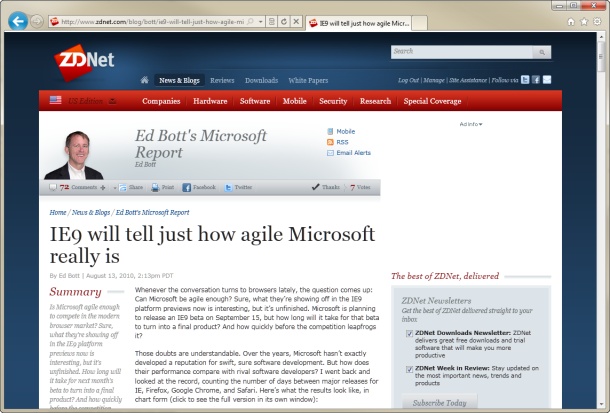Internet Explorer 9 beta arrives

Microsoft has delivered the public beta of Internet Explorer 9, the upcoming update to its web browser, adding a new user interface designed to be as stripped-down as possible.
The beta was unveiled on Wednesday at simultaneous events in San Francisco and London. Developers have had access to the new browser's layout and JavaScript engines through four platform preview releases sent out since March.
The aim of the browser and new user interface is to deliver "rich immersive sites that look like a Windows application, where it'll be hard to tell that it's a web page at all", said Ian Moulster, product manager for Internet Explorer 9 (IE9) at Microsoft UK.

The user interface in the IE 9 beta focuses on essential elements. Photo credit: ZDNet.com
The software maker has taken a strict metric- and research-driven approach to IE9's development, and the new user interface follows on from the work done in the platform previews, according to Moulster.
Microsoft's internal research showed that "57 percent of the time, people on a PC are using their browser", Moulster said. The same research showed that many features in the browser were not being used, with fewer than one-third of people using bookmark management, and less than one-quarter clicking the 'home' button, he added.
In practice, people just used the browser by typing in URLs or clicking on links they came across, rather than using the tools provided. That contrasted with people's use of operating system features — a difference that "had implications for the browser", Moulster said.
In its platform previews for IE9, Microsoft focused on interoperability. It worked with standards bodies on developing a common platform that would allow designers to use one set of markup for both web pages and applications. In the beta, there is little change in the HTML and JavaScript from the platform previews. The standards support means that instead of coding around browser differences, developers will be able to focus on the site, rather than the browser.
Microsoft wants the same to be true for the user, according to Moulster. "The browser is a theatre, the web is the play," he said.
The result is the new interface in the beta, where the browser is designed to fade into the background, to allow the website to take centre stage. The IE9 beta is intended to be clean and unobtrusive, according to Moulster, so it provides just one bar for all the controls, just one combined search and address box, and inline tabs. Building on the Vista and Windows 7 user interfaces and using Aero Glass, Microsoft has pared away logos, menus, text and buttons to leave only these essential elements.
Windows 7 users will get the best user experience, as IE9 takes advantage of Windows 7's task bar and Aero Snap features. Web pages can be dragged onto the taskbar and treated like native applications. There is a choice of custom browser colours, and the beta provides support for Windows 7 features such as jumplists and icon overlays.
Other new features for all users include improved privacy tools, a download manager with trust ratings for files, and a new tab session manager with indicators that show just how often sites are visited. Warnings and dialogs now appear on the bottom of the screen, while the 'favourite' bar disappears completely — something Moulster called "quieting the browser".
Microsoft demonstrated sites built using HTML 5, which takes advantage of IE9's fast JavaScript engine and its GPU-accelerated graphics performance. One of the HTML 5 sites was the collaborative art project Infinite Canvas, whose site designer Josh Davis said the combination of IE9 and HTML proved to be a compelling developer experience. "It's in the browser, it's HTML 5 — and it's twice as fast as Flash is ever going to be. Flash isn't going away, but now we can stop using it for all this unnecessary navigation and use it for the heavy lifting," Davis said.